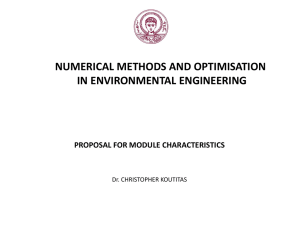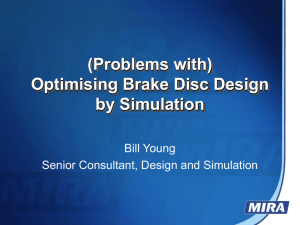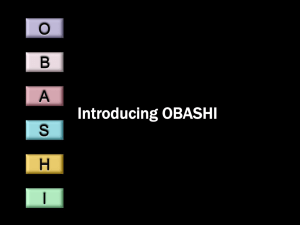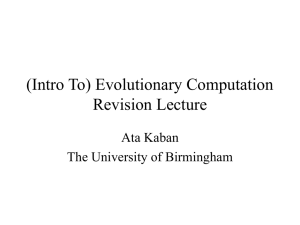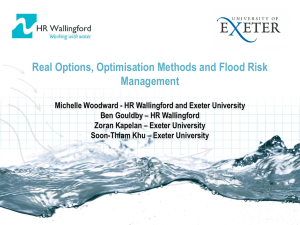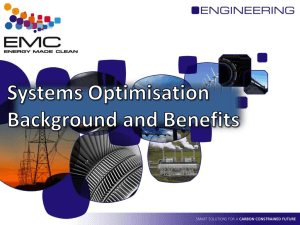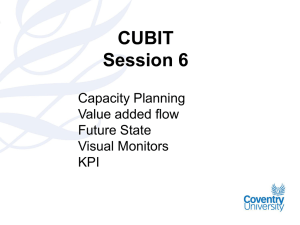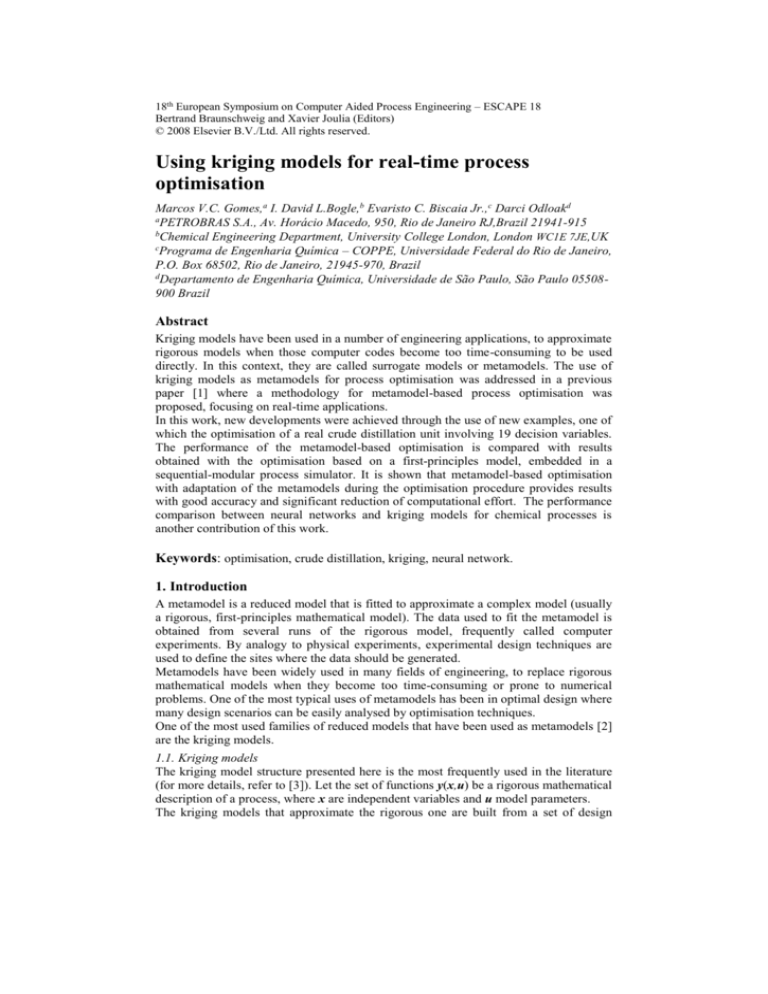
18th European Symposium on Computer Aided Process Engineering – ESCAPE 18
Bertrand Braunschweig and Xavier Joulia (Editors)
© 2008 Elsevier B.V./Ltd. All rights reserved.
Using kriging models for real-time process
optimisation
Marcos V.C. Gomes,a I. David L.Bogle,b Evaristo C. Biscaia Jr.,c Darci Odloakd
a
PETROBRAS S.A., Av. Horácio Macedo, 950, Rio de Janeiro RJ,Brazil 21941-915
b
Chemical Engineering Department, University College London, London WC1E 7JE,UK
c
Programa de Engenharia Química – COPPE, Universidade Federal do Rio de Janeiro,
P.O. Box 68502, Rio de Janeiro, 21945-970, Brazil
d
Departamento de Engenharia Química, Universidade de São Paulo, São Paulo 05508900 Brazil
Abstract
Kriging models have been used in a number of engineering applications, to approximate
rigorous models when those computer codes become too time-consuming to be used
directly. In this context, they are called surrogate models or metamodels. The use of
kriging models as metamodels for process optimisation was addressed in a previous
paper [1] where a methodology for metamodel-based process optimisation was
proposed, focusing on real-time applications.
In this work, new developments were achieved through the use of new examples, one of
which the optimisation of a real crude distillation unit involving 19 decision variables.
The performance of the metamodel-based optimisation is compared with results
obtained with the optimisation based on a first-principles model, embedded in a
sequential-modular process simulator. It is shown that metamodel-based optimisation
with adaptation of the metamodels during the optimisation procedure provides results
with good accuracy and significant reduction of computational effort. The performance
comparison between neural networks and kriging models for chemical processes is
another contribution of this work.
Keywords: optimisation, crude distillation, kriging, neural network.
1. Introduction
A metamodel is a reduced model that is fitted to approximate a complex model (usually
a rigorous, first-principles mathematical model). The data used to fit the metamodel is
obtained from several runs of the rigorous model, frequently called computer
experiments. By analogy to physical experiments, experimental design techniques are
used to define the sites where the data should be generated.
Metamodels have been widely used in many fields of engineering, to replace rigorous
mathematical models when they become too time-consuming or prone to numerical
problems. One of the most typical uses of metamodels has been in optimal design where
many design scenarios can be easily analysed by optimisation techniques.
One of the most used families of reduced models that have been used as metamodels [2]
are the kriging models.
1.1. Kriging models
The kriging model structure presented here is the most frequently used in the literature
(for more details, refer to [3]). Let the set of functions y(x,u) be a rigorous mathematical
description of a process, where x are independent variables and u model parameters.
The kriging models that approximate the rigorous one are built from a set of design
2
M.V. C. Gomes et al
points (X,Y) obtained from runs of the rigorous model for a set of parameters u0. They
are composed by a linear regression model and a random function:
yˆ i x βiT f (x) zi (x),i 1nY
(1 )
The first term is usually a low-order polynomial. The random functions zi have the
following form:
z i riT (x) R 1(Y Fβi )
(2 )
where
T
T
nX
nX
ri ( x) ij(ij, X kj x j ) and R im ( Xm ) ij(ij, X kj X mj ) ,
j1
j1
k, m 1 nP
(3 )
The matrix F is obtained by computing the f(x) values for the design inputs X. are
correlation models [4], usually built as functions of the distance between two sites.
Therefore, Rim(Xm) is a matrix that contains the correlations between the design sites,
and ri(x) is a vector that contains the correlations among a new site x and the design
sites.
1.2. Applications on chemical processes
Palmer and Realff [2] proposed the first work based on metamodels applied to chemical
process design, using kriging models and polynomials. Later, Gomes et al.[1] proposed
the use of metamodels for RTO applications. The alkylation process optimisation
problem was used to validate the proposed methodology. Accurate solutions were
reported with the metamodel approach with less than 30% of the required runs of the
original model when compared to the solution based exclusively on the original model.
As an extension of this work, it was attempted [5] to apply this methodology to two
other examples, one of them a large real optimisation problem of a crude distillation
unit (CDU). It was concluded that the previous proposed procedures should be
improved, in order to allow their successful application to a wider class of problems.
This improvement was accomplished by the introduction of a SAO algorithm.
1.3. Sequential Approximate Optimisation (SAO)
SAO is a procedure used to solve optimisation problems when the model computation is
time-consuming. The optimisation problem is decomposed into subproblems, confined
to a fraction of the original search space, that are solved sequentially based on a trustregion strategy. The original problem functions are usually replaced by polynomials.
The way by which the trust region is changed, the assessment of the model
approximations and the termination criteria are important issues of the SAO algorithm.
In this work, some aspects of a new methodology based on the use of metamodels for
real-time process optimisation are presented. This methodology comprises the
metamodel generation and its use along with a new SAO algorithm that contains
automatic procedures for adaptation and assessment of metamodels.
In this work, the highlights of the proposed methodology are presented, along with the
results obtained with the optimisation of a real, industrial-scale crude distillation unit.
2. Example
In order to validate the proposed methodologies, a real industrial problem has been
addressed: the optimisation of the Crude Distillation Unit (CDU) and the Solvents Units
of RECAP, a Brazilian refinery of PETROBRAS.
3
Using kriging models for real-time process optimisation
2.1. Process description
The crude oil is fed to the pre-flash column (N507) of the CDU, from which three
streams are obtained. The top product is light naphtha which is sent to the solvents
units. An intermediate stream constitutes extra-light diesel (DEL). The bottom stream is
sent to the atmospheric column (N506), where it is split into the atmospheric residue
(RAT), Kerosene, heavy diesel oil and heavy naphtha. The light and the heavy naphtha
streams constitute the Solvents Units feed, where the high-valued products rubber
solvent (SBO) and Paint diluent (DTI) are obtained after many separation operations. A
third stream containing the heaviest remains of the feed is mixed to DEL, Kerosene and
Heavy Diesel streams to generate the diesel oil stream. A recycle stream between
column N751 and the solvents units feed tank is used to minimize losses of SBO.
Figure 1 – Scheme of the CDU and the Solvents Units of RECAP/PETROBRAS.
2.2. The process model
The process model was built using PETROX, a proprietary sequential-modular process
simulator from PETROBRAS. The simulation comprises 53 components and pseudocomponents and 64 unit operation modules, including 7 distillation columns and a
recycle stream. All modules are built with rigorous, first-principles models. For
optimization applications, PETROX was linked to NPSOL, an SQP optimisation
algorithm.
2.3. The optimisation problem
The optimisation problem takes the following form:
min f y x , x
x
(4 )
s.t. : hy x , x 0 ; gy x , x 0
The set of functions y(x) in Equation (4) comprises all variables whose values are to be
obtained from runs of the process simulator to compute the objective function and
equality or inequality constraints. The objective function is the operational cost (Γ):
nprods
i 1
nutils
$iprods producti $ utils
utility j $feed feed
j
(5 )
j1
Table 1 presents the description of the decision variables and constraints of the
problem.The problem inequality constraints (constraints 3-21) are related to product
specifications and safety or performance limits. The equality constraints 1 and 2 were
included to model the heat integration between the atmospheric column and the feed
pre-heating train. Another 18 process variables take part of the objective function, as
4
M.V. C. Gomes et al
product flow rates or utilities.
Table 1 - Decision variables and constraints of the optimisation problem
1
2
3
4
5
6
7
8
9
10
11
12
13
14
15
16
17
18
19
Decision variables (x)
Crude flow rate
Steam flow rate to N507
Steam flow rate to N506
Pumparound flow rate
Atmospheric heater outlet temperature
Kerosene flow rate
Diesel reflux flow rate
Heavy naphta molar flow rate
DEL flow rate
Temp. #2 N507
N701 feed flow rate
N701 control temperature
N703 control temperature
N703 reflux flow rate
N752 control temperature
N753 reflux flow rate
N506 pumparound outlet flow rate
N753 top/feed ratio
preheating train heat duty to N506
1
2
3
4
5
6
7
8
9
10
11
12
13
14
15
16
17
18
19
20
21
Constraints (h,g)
Equality constraint #1 – heat integration
Equality constraint #2 – heat integration
Light naphta flow rate
Diesel ASTMD86 85% temperature
Naphta recycle flow rate
DTI– Dry point
DTI– Initial boiling point ASTMD86
N703 reboiler steam flow rate
SBO– Dry point
SBO– Initial boiling point ASTMD86
N753 control temperature
N753 reboiler steam flow rate
N753 bottom flow rate
Temp #2 N506
N506 #10 – molar flow rate
N506 #22 – molar flow rate
N507 #10 – molar flow rate
N701 #17 – molar flow rate
N703 #3 – molar flow rate
N752 #8 – molar flow rate
N753 #14 – molar flow rate
3. Methodology: Metamodeling and SAO
The methodology for the use of metamodels in RTO begins with the off-line generation
of a base metamodel. All the following steps shall be performed during the optimisation
procedure. The use of this metamodel in a real-time environment requires its adaptation
to face not only changes in the process behaviour, but eventual mismatches between the
metamodel and the rigorous model. A validation procedure is required to allow the
assessment of the metamodel throughout the optimisation procedure, as well as a
suitable set of termination criteria. A comprehensive description of the proposed
methodology is presented in [5].
3.1. Generation of the base metamodel
The main aspects for metamodel generation are: (i) Generation of training data, through
an experimental design strategy; (ii) Independent variable selection; (iii) Parameter
estimation and (iv) Metamodel validation.
The training data is generated based on the Latin Hypercube Design (LHD). A forward
stepwise regression procedure is used to select the independent variables to be used by
the metamodels of each dependent variable.
For kriging models, the structure is defined by the set of independent variables selected
– including quadratic terms – and the selection of the correlation model. The parameter
estimation is performed by a maximum likelihood procedure. For neural nets, the
activation function to be used is defined a priori. The structure is completed by the
selection of the number of neurons in the hidden layer. A backpropagation procedure
has been used for training.
The procedure is presented in Figure 2. It starts with the training data, a set of candidate
metamodel structures and a set of sets of initial estimates for the metamodel parameters.
The best metamodel will be the one that provides the smaller prediction errors
computed with a set of independent validation data. The best metamodel will be the one
that provides the smaller prediction errors, computed with a set of independent
validation data.
3.2. Sequential Approximate Optimisation (SAO)
The SAO algorithm proposed in [6] was used as a basis of the algorithm proposed here
(Figure 3). The key features of this algorithm are related to the way by which the base
metamodel is adapted and assessed, the trust region updating procedure and the
5
Using kriging models for real-time process optimisation
termination criteria for the optimisation procedure.
CONFIGURATION
Training data
Set of model structures {S1,…,Sk,…,SnS}
Sets of parameter estimates {1,…, j, …, n}
Rigorous Model
Base Metamodel
SAO Parameters
Problem configuration: Variables,
,
Limits, Initial estimates
Validationdata
Variable
selection
Parameter
Estimation
Compute
prediction
errors
Rigorous
Model
Metamodel Adaptation
Keep best
metamodel
Optimisation
no
k > nS ?
yes
no
j > n?
yes
Update Trust
Region
Check Termination Criteria
NO
OK?
Best metamodel
YES
Figure 2 – The general procedure for metamodel
generation
END
Figure 3 – SAO strategy applied to the
metamodel-based optimisation.
4. Results
Kriging models and neural nets were generated for each of the 39 dependent variables
required for the computation of the objective function and the constraints. Table 2
presents the main characteristics of the metamodels (for more details, refer to [5]).
To simulate a real-time operation, a set of case studies (Table 3) were proposed, where
changes in the process behaviour were introduced by changing the model parameters.
The objective was to verify if the adaptation procedure would be able to change the base
metamodels in order to allow acceptable solutions to the optimisation problem. The
selected model parameters were the feed composition (I and II), the global heat
coefficient of the atmospheric column pumparound (UPPA – III and IV) and the global
heat coefficient of the condenser of column N753 (UCOND - V).
Table 2 - Main characteristics of the metamodels
Size of training data set
Size of validation data set
Number of initial estimates
kriging
186
399
10
Regression model
Correlation models
quadratic
Gauss
Spline
Spherical
Neurons in the hidden layer
Neural nets
Activation functions
2-5
Hidden layer
Log-sigmoid
Output layer
Linear
Table 3 – Cases for assessment of the SAO/metamodel procedure
Case
Base
I
II
III
IV
V
CDU Feed, °API
33.0
32.5
33.5
33.0
33.0
33.0
UPPA
967
967
967
800
1300
967
UCOND
750
750
750
750
750
900
Two indexes were used to assess the proposed methodology, whose computation is
described in Equation (6). The relative benefit shows the fraction of the profit obtained
with the rigorous solution that could be attained with the metamodel/SAO procedure. x 0
6
M.V. C. Gomes et al
is the initial state of the decision variables, xRIG is the rigorous solution and xSAO is the
approximate solution. The relative effort shows the ratio between the number of
simulation runs with the rigorous model required by the metamodel/SAO procedure and
the correspondent number of simulations required by the rigorous solution.
Benefit % 100
x F x
Fobj x SAO Fobj x 0
Fobj
RIG
0
Effort % 100
obj
NSIM SAO
NSIM RIG
(6 )
Table 4 presents the obtained results. In most cases, a relative benefit above 85% was
obtained, with a minimum value of 77%. The observed relative computational effort
remained below 50% for 9 of the 12 cases studied, showing that good accuracy on the
optimisation results was obtained with significant reduction of the computational effort.
Table 4 - Attained benefit and relative computational effort with the SAO/metamodel procedure.
Case
Base
I
II
III
IV
V
Kriging models
Benefit, %
Effort, %
94.0
35.8
78.7
42.5
89.0
22.4
85.2
21.1
97.9
87.0
90.2
29.7
Neural nets
Benefit, %
Effort, %
97.1
43.1
77.1
42.5
89.7
53.1
84.6
12.9
93.9
19.5
94.6
54.7
5. Conclusions
A new strategy for Real-Time Optimisation combining metamodels and a Sequential
Approximate Optimisation (SAO) procedure has been proposed. This methodology is
based on automatic procedures, aiming its use in real-time applications. Kriging models
and neural nets were used as metamodels.
The methodology was tested with an example involving the optimisation of a crude
distillation unit, using the first-principles models of a sequential-modular process
simulator. The solution of the corresponding optimisation problem with this rigorous
model required considerable computational effort.
It is shown that the proposed methodology provides solutions with good accuracy and a
significant reduction of computational effort. Another advantage of this approach is that
the occurrence of numerical problems during the solution of the rigorous model does
not result in the failure of the optimisation procedure. The reported results show that
kriging models can be used to model chemical processes involving a large number of
independent variables, and that they can perform as good as or better than neural nets.
References
[1] M.V.C.Gomes, I.D.L.Bogle, D. Odloak, E.C.Biscaia Jr., An application of metamodels for
process optimisation, Proceedings of the 16th European Symposium on Computer Aided
Process Engineering, (2006) 1449.
[2] K. Palmer, M. Realff, Trans IchemE, 80 (2002) Part A 760.
[3] T.J. Santner, B.J. Williams, & W.I. Notz, Springer-Verlag New York, Inc. (eds.) The
Design and Analysis of Computer Experiments. New York, 2002.
[4] S.N. Lophaven, H.B. Nielsen, J. Sondergaard, DACE - A MATLAB Kriging Toolbox.
Technical University of Denmark, Technical Report IMM-TR2002-12, 2002.
[5] M.V.C.Gomes, Otimização Seqüencial por Aproximações – Uma aplicação em tempo real
para o refino do petróleo, D.Sc. Thesis, (in portuguese), PEQ/COPPE/UFRJ, Rio de
Janeiro, Brazil, 2007.
[6] A.A.Giunta, M.S.Eldred, Proceedings of the 8th AIAA/USAF/NASA/ISSMO Symposium
on Multidisciplinary Analysis and Optimisation, Long Beach, USA, AIAA-2000-4935.


